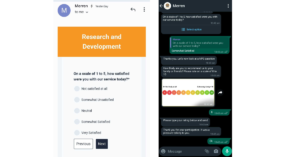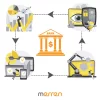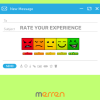While curating business strategies, relying on existing response rates might be a bit of an injustice to the majority of your customer base. Why so, you may ask. Having low survey response rates might be misleading. Marketers might scurry to curate business communications based on a little bit of data. This data does not represent the majority of your user base. In this blog, we will understand why low survey response rates matter in customer feedback surveys.
What are low response rates?
Response rate refers to the percentage of individuals who participate in a survey or provide feedback compared to the total number of people who were invited or targeted. Low survey response rates indicate a lack of engagement and can impact the reliability and representativeness of the survey results.
The Disadvantages of Minimum Response Rates in Customer Feedback Surveys
Marketers might just ask ‘ why does it matter to them in the long run? They can wait for a few weeks for the survey to build up to an acceptable sample size, isnt it?’. However, there are multiple drawbacks to waiting for the build up. This might tamper with the way you create communication protocols. Let us discuss the drawbacks of low response rates during feedback surveys.
Limited insights, limited success
Imagine a world where businesses make crucial decisions without sufficient data. Scary, isn’t it? Low response rates in customer feedback surveys leave organizations with limited insights into their customers’ experiences. Without a representative sample, it’s like trying to solve a puzzle with half the pieces missing. You risk making decisions that may not align with your customers’ needs and preferences, ultimately hampering your chances of success.
Example: A popular coffee chain launched a survey to gather customer feedback on potential new flavors for the season. Unfortunately, only a small fraction of customers responded by the time the decision had to be made. The decision was made on a smaller sample size, which ended up being skewed and not representative of their customer base. As a result, the chain introduced a trendy avocado-flavored latte, only to discover later that the majority of customers actually preferred a more classic approach. This sums up to wasted time and resources.

Missed revenue opportunities
It’s like leaving money on the table and watching your money slip away. Minimal completion rate in customer feedback surveys can have a direct impact on your sales, upselling efforts, and even customer retention.
Example: An electric two-wheeler manufacturer collects customer satisfaction feedback after a test drive. It was found that the sales conversion of those who responded was higher. A deeper analysis found that the sales team were able to use an individual’s satisfaction data to close faster or address concerns better. The lower response rate, in this, was directly impacting revenue.
Missed opportunities for improvement
Imagine you’re sailing a ship, and your passengers each have a small piece of the map that can guide you towards smoother waters. What happens if only a few of them actually share their experiences? Significant differences in response rates can leave us clueless about what needs fixing, tweaking, or improving. Without these precious insights and survey data, we might miss out on golden opportunities to enhance our products or services.
Example: A fashion retail chain received varying levels of responses to their customer experience survey at their different locations. A year later, it was found that the average sales at locations with under 1% customer response rate had grown significantly slower than those with over 1%. In fact, they found a high correlation between customer feedback and sales. While it is possible that some of this might be attributable to the deliberate suppression of feedback from poorly performing locations, at least some part of it was attributable to a lack of actionable insights for improvement.

Misguided priorities
If you have a list of customer pain points, but without an adequate response rate, it’s challenging to determine which issues should be prioritized. When a survey’s response rate is low, it is impossible to distinguish between signal and noise. Hence, businesses may end up allocating resources to fix problems that affect only a small fraction of their customer base. It’s like wearing earmuffs to a concert—you’re missing out on the important sounds!
Example: A credit card provider was collecting transactional NPS data at various touchpoints in the customer journey. Their net promoter score had an abysmally low response rate. Irrespective of how much effort they made to improve it by identifying and reinforcing their weak touchpoints, the NPS would just not rise. The survey researchers discovered that the response rate to their NPS data was less than 2%. It took effort for the customers to respond to their NPS survey and the only customers who were willing to make that effort were overwhelmingly those who were annoyed with their experience. While it was good to know why their experience was poor, their experience was not representative of the real customer base. Hence, no amount of effort based on the insights drawn from those 2% responses moved the NPS needle. By just making the NPS survey easier to respond to, the company saw an improvement in overall NPS (because the responses comprised a more representative set of customers and not just the annoyed ones) and could identify the real weaknesses in their customer journey, which when improved led to further increase in the NPS.
Get a High Response Rate For Feedback Surveys
The right way to conduct a survey should be to assess the goals on priority. When people share their feedback, one must focus on the in-moment nature of capturing responses. This brings fresh insights to the table without putting a cognitive stress on responders. How to achieve this? Here’s how.

Messenger tools for online surveys
Facebook messenger surveys and Whatsapp can capture faster data than most browser based platforms. You can now create Whatsapp surveys in less than 5 minutes. This is one of the best approaches to gather insights real-time and reach your survey participants quickly without other digital obstacles.
AMP email facilities
Browser based email is the one where an external link takes you away from the inbox. This is the main culprit that affects a survey’s response rate. Using AMP facilities, potential respondents can reply within the email body right from their device.
Conclusion
If you want your surveys to reach the right target audience, switch to a different approach of conducting customer feedback protocols. Merren offers a faster way to gather higher response rate from every potential responders using messenger based tools and dynamic AMP email facilities. Sign up for a 14 day free trial and upgrade the way you conduct survey research. You can also check our pricing plan and upgrade to launch an unlimited number of surveys. Increase your survey response rates today!





